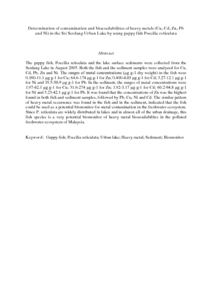Citation
Yap, Chee Kong and Edward, Franklin Berandah and R. A. A. Emilia, and F. I. Ainey, and Ismail, Ahmad and Tan, Soon Guan and Yusof, Shahrizad
(2008)
Determination of contamination and bioavailabilities of heavy metals (Cu, Cd, Zn, Pb and Ni) in the Sri Serdang Urban Lake by using guppy fish Poecilia reticulata.
Trends in Applied Sciences Research, 3 (1).
pp. 69-75.
ISSN 1819-3579; ESSN: 2151-7908
Abstract
The guppy fish, Poecilia reticulata and the lake surface sediments were collected from the Serdang Lake in August 2005. Both the fish and the sediment samples were analyzed for Cu, Cd, Pb, Zn and Ni. The ranges of metal concentrations (μg g-1 dry weight) in the fish were 0.160-11.1 μg g-1 for Cu; 64.6-174 μg g-1 for Zn; 0.400-4.03 μg g-1 for Cd; 3.27-12.1 μg g-1 for Ni and 19.5-50.9 μg g-1 for Pb. In the sediment, the ranges of metal concentrations were 1.97-62.1 μg g-1 for Cu; 31.6-274 μg g-1 for Zn; 1.92-3.17 μg g-1 for Cd; 60.2-94.8 μg g-1 for Ni and 3.23-42.1 μg g-1 for Pb. It was found that the concentrations of Zn was the highest found in both fish and sediment samples, followed by Pb, Cu, Ni and Cd. The similar pattern of heavy metal occurrence was found in the fish and in the sediment, indicated that the fish could be used as a potential biomonitor for metal contamination in the freshwater ecosystem. Since P. reticulata are widely distributed in lakes and in almost all of the urban drainage, this fish species is a very potential biomonitor of heavy metal bioavailabilites in the polluted freshwater ecosystem of Malaysia.
Download File
![[img]](http://psasir.upm.edu.my/13951/1.hassmallThumbnailVersion/Determination%20of%20contamination%20and%20bioavailabilities%20of%20heavy%20metals.pdf)  Preview |
|
PDF (Abstract)
Determination of contamination and bioavailabilities of heavy metals.pdf
Download (149kB)
| Preview
|
|
Additional Metadata
Actions (login required)
 |
View Item |

